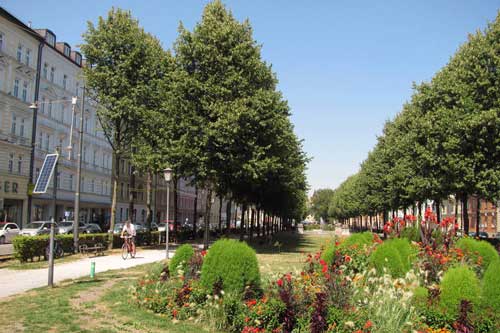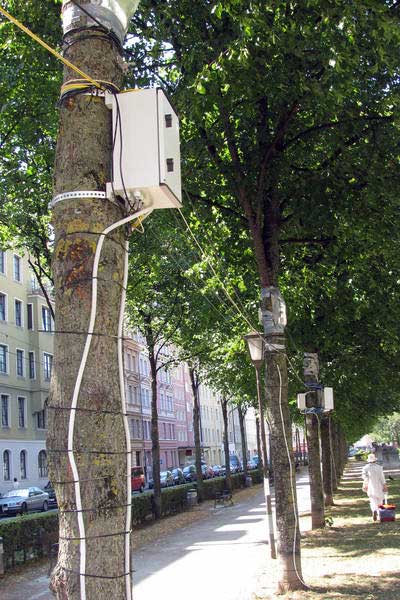| Sep 14, 2016 |
Trees transpire for a cool city
|
|
(Nanowerk News) Small-leaved limes do not transpire to the same extent in all environments as a study by Mohammad Rahman from the Technical University of Munich (TUM) concludes. In the heat of summer, their transpiration – the loss of water from their leaves – cools city squares with an open layout and green areas more effectively than narrow, plastered squares. This is caused by local differences in meteorology and the ground.
|
 |
| Solar-powered measuring system on the green space at Bordeaux Platz in Munich. (Photo: M. Rahman/ TUM)
|
|
Street canyons, roads, and squares get particularly hot in summer. Trees cool the asphalt under their crowns by up to 20°C and the air by up to two degrees Celsius as demonstrated by studies conducted by Mohammad Rahman from the Chair for Strategic Landscape Planning and Management at TUM. The latest findings by the plant ecologist prove that small-leaved limes (Tilia cordata), which are particularly common in cities, are able to cool their surroundings to different degrees depending on the conditions at their place of growth.
|
|
Urban trees growing in green spaces on squares with an open layout provide an optimal cooling effect on summer days. The cooling power of these ‘green air conditioners’ is 20 percent lower on narrow, plastered squares with small openings for the trees. These were the results of Rahman’s measurements for small-leaved limes on two squares in the heart of Munich: the green Bordeaux Platz and the plastered Pariser Platz. “Local meteorological conditions vary greatly and affect how the trees transpire,” the researcher explained.
|
|
Cooling Effect from Trees Similar to That of an Air Conditioner
|
|
The plants release water vapor when they absorb carbon dioxide for photosynthesis via their stomata. At Bordeaux Platz, the researchers measured a sap flow rate of up to eight liters per hour in the vascular system of a tree. Mathematically speaking, this means that the small-leaved lime achieves a cooling power of up to 2.3 kilowatts. “The trees’ output is comparable to that of an air conditioner for a single room,” said the plant ecologist.
|
|
Rahman’s measurements show that small-scale differences in climate cause the plants to transpire in different ways. Wind blows across open green spaces at a higher speed, the air is less saturated with water, and the trees are exposed to more sunlight as compared to a narrow plastered surface that is surrounded by buildings on all sides. Furthermore, the ground of the green spaces at Bordeaux Platz is cooler and moister than the completely covered Pariser Platz.
|
 |
| Small-leaved lime with measuring device at Bordeaux Platz in Munich. (Photo: M. Rahman/ TUM)
|
|
“These conditions encourage transpiration and hence the trees’ cooling effect,” said the plant ecologist. In order to measure all these parameters, he and five other researchers installed around 80 sensors on ten trees and several streetlamps in downtown Munich in the summer of 2015.
|
|
“In order to reduce the amount of heat in cities, it would make sense to create more open spaces and squares—this would allow us to directly influence the cooling potential of the trees,” Rahman recommends. In addition, the plant ecologist advises that trees be planted in green spaces such as road verges rather than directly in openings in the plastered ground. This allows heated-up surface layers to cool down faster.
|
|
Publication
|
|
Rahman M (2016): Comparing the cooling benefits of different urban tree species at contrasting growth conditions. In: Gesellschaft für Ökologie e.V. (ed.): Verhandlungen der Gesellschaft für Ökologie 46. Jahrestagung der Gesellschaft für Ökologie, 5.-9. Sep. 2016 in Marburg. Görich & Weiershäuser, Marburg, pp. 367-368
|


